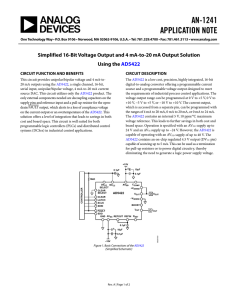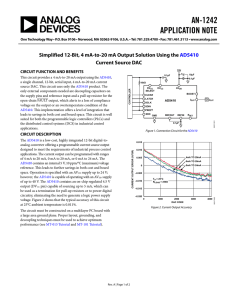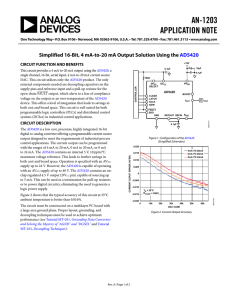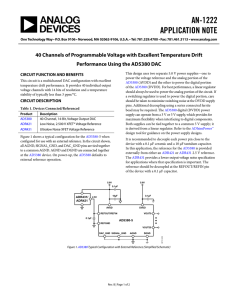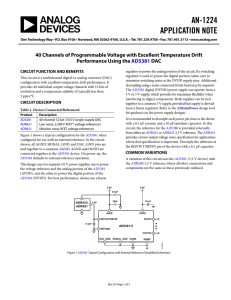AN-1202 APPLICATION NOTE
advertisement
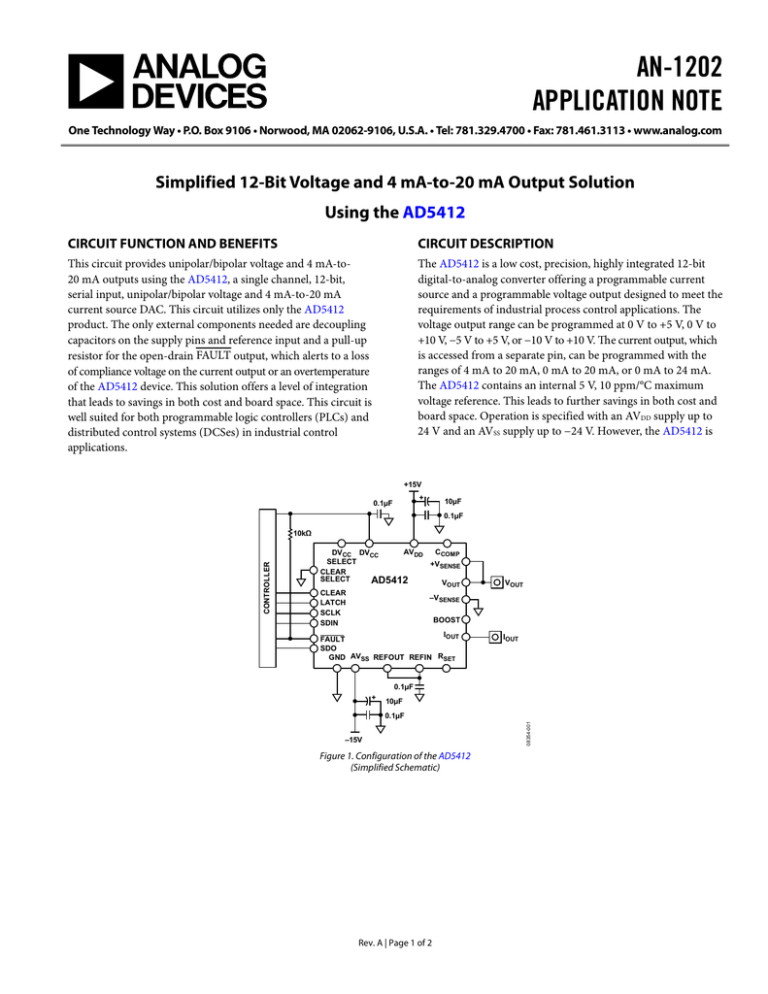
AN-1202 APPLICATION NOTE One Technology Way • P.O. Box 9106 • Norwood, MA 02062-9106, U.S.A. • Tel: 781.329.4700 • Fax: 781.461.3113 • www.analog.com Simplified 12-Bit Voltage and 4 mA-to-20 mA Output Solution Using the AD5412 CIRCUIT FUNCTION AND BENEFITS CIRCUIT DESCRIPTION This circuit provides unipolar/bipolar voltage and 4 mA-to20 mA outputs using the AD5412, a single channel, 12-bit, serial input, unipolar/bipolar voltage and 4 mA-to-20 mA current source DAC. This circuit utilizes only the AD5412 product. The only external components needed are decoupling capacitors on the supply pins and reference input and a pull-up resistor for the open-drain FAULT output, which alerts to a loss of compliance voltage on the current output or an overtemperature of the AD5412 device. This solution offers a level of integration that leads to savings in both cost and board space. This circuit is well suited for both programmable logic controllers (PLCs) and distributed control systems (DCSes) in industrial control applications. The AD5412 is a low cost, precision, highly integrated 12-bit digital-to-analog converter offering a programmable current source and a programmable voltage output designed to meet the requirements of industrial process control applications. The voltage output range can be programmed at 0 V to +5 V, 0 V to +10 V, −5 V to +5 V, or −10 V to +10 V. The current output, which is accessed from a separate pin, can be programmed with the ranges of 4 mA to 20 mA, 0 mA to 20 mA, or 0 mA to 24 mA. The AD5412 contains an internal 5 V, 10 ppm/°C maximum voltage reference. This leads to further savings in both cost and board space. Operation is specified with an AVDD supply up to 24 V and an AVSS supply up to −24 V. However, the AD5412 is + +15V 0.1µF 10µF 0.1µF CCOMP AVDD DVCC DVCC SELECT +VSENSE CLEAR SELECT AD5412 VOUT CLEAR –VSENSE LATCH SCLK BOOST SDIN IOUT FAULT SDO GND AVSS REFOUT REFIN RSET VOUT IOUT 0.1µF + 10µF 0.1µF –15V Figure 1. Configuration of the AD5412 (Simplified Schematic) Rev. A | Page 1 of 2 08354-001 CONTROLLER 10kΩ AN-1202 Application Note LEARN MORE capable of operating with an AVDD supply of up to 40 V. The AD5412 contains an on-chip regulated 4.5 V output (DVCC pin) capable of sourcing up to 5 mA. This can be used as a termination for pull-up resistors or to power digital circuitry, eliminating the need to generate a logic power supply. Kester, Walt. 2005. The Data Conversion Handbook. Analog Devices. Chapters 3 and 7. Figure 2 and Figure 3 show that the typical accuracy of this circuit at 25°C ambient temperature is better than 0.011% for both current and voltage outputs. MT-031 Tutorial, Grounding Data Converters and Solving the Mystery of AGND and DGND. Analog Devices. The circuit must be constructed on a multilayer PC board with a large area ground plane. Proper layout, grounding, and decoupling techniques must be used to achieve optimum performance (see Tutorial MT-031, Grounding Data Converters and Solving the Mystery of "AGND" and "DGND," and Tutorial MT-101, Decoupling Techniques). MT-015 Tutorial, Basic DAC Architectures II: Binary DACs. Analog Devices. MT-101 Tutorial, Decoupling Techniques. Analog Devices. Voltage Reference Wizard Design Tool. Data Sheets and Evaluation Boards AD5412 Data Sheet. AD5422 Evaluation Board (Compatible with AD5412). REVISION HISTORY 0.010 4/13—Rev. 0 to Rev. A 4mA TO 20mA 0mA TO 20mA 0mA TO 24mA 0.005 Changed Document Title from CN-0097 to AN-1202 .............................................................................. Universal 0 7/09—Revision 0: Initial Version –0.005 –0.010 TA = 25°C RLOAD = 250Ω –0.015 08354-002 CURRENT OUTPUT ERROR (%FSR) 0.015 –0.020 0 1000 2000 DAC CODE 3000 4000 Figure 2. Current Output Accuracy 0.005 0.001 –0.001 –0.003 0V TO +5V 0V TO +10V –5V TO +5V –10V TO +10V –0.005 –0.007 –0.009 –0.011 TA = 25°C 08354-003 VOLTAGE OUTPUT ERROR (%FSR) 0.003 –0.013 –0.015 0 1000 2000 DAC CODE 3000 4000 Figure 3. Voltage Output Accuracy ©2009–2013 Analog Devices, Inc. All rights reserved. Trademarks and registered trademarks are the property of their respective owners. AN08354-0-4/13(A) Rev. A | Page 2 of 2
